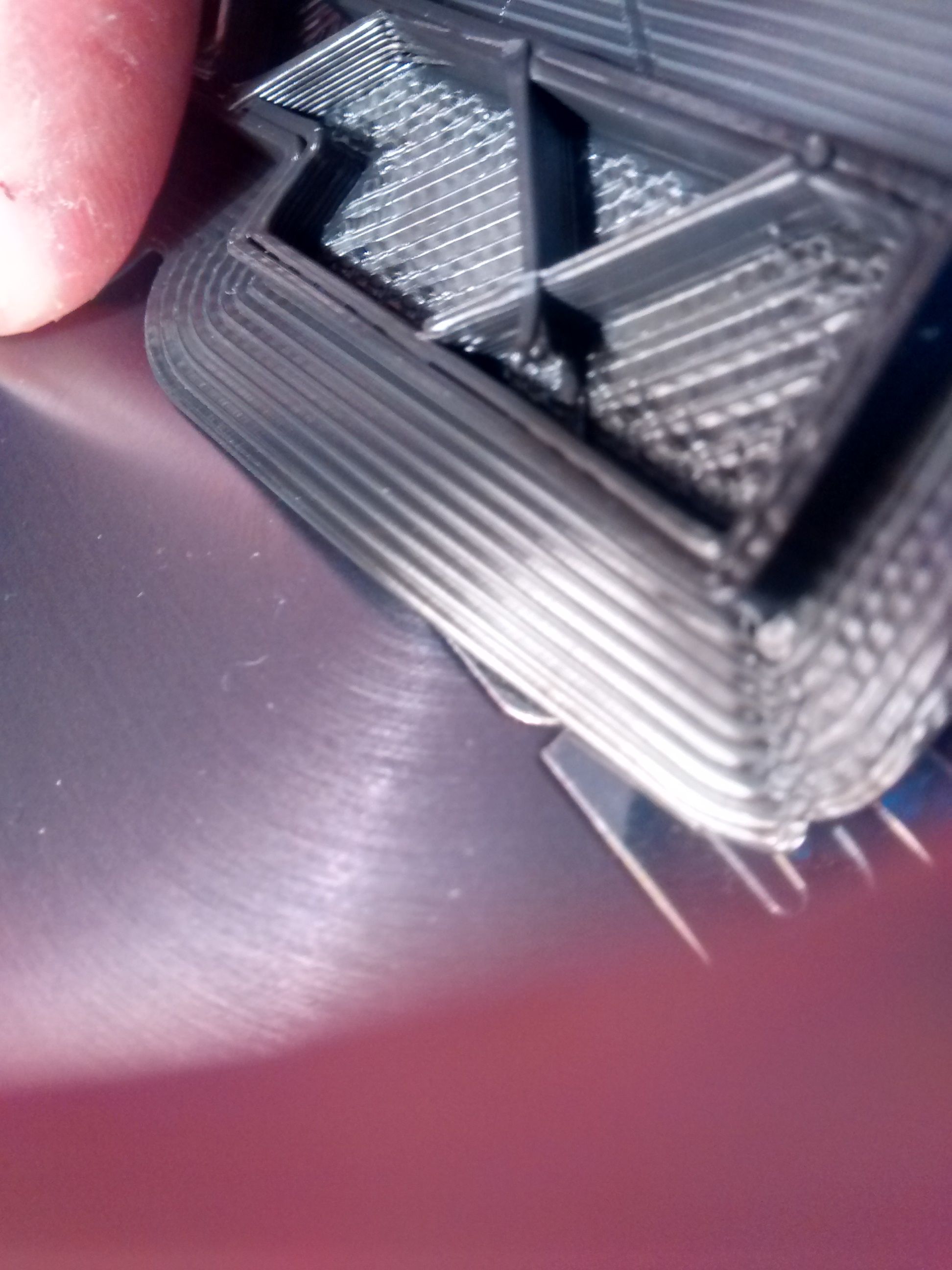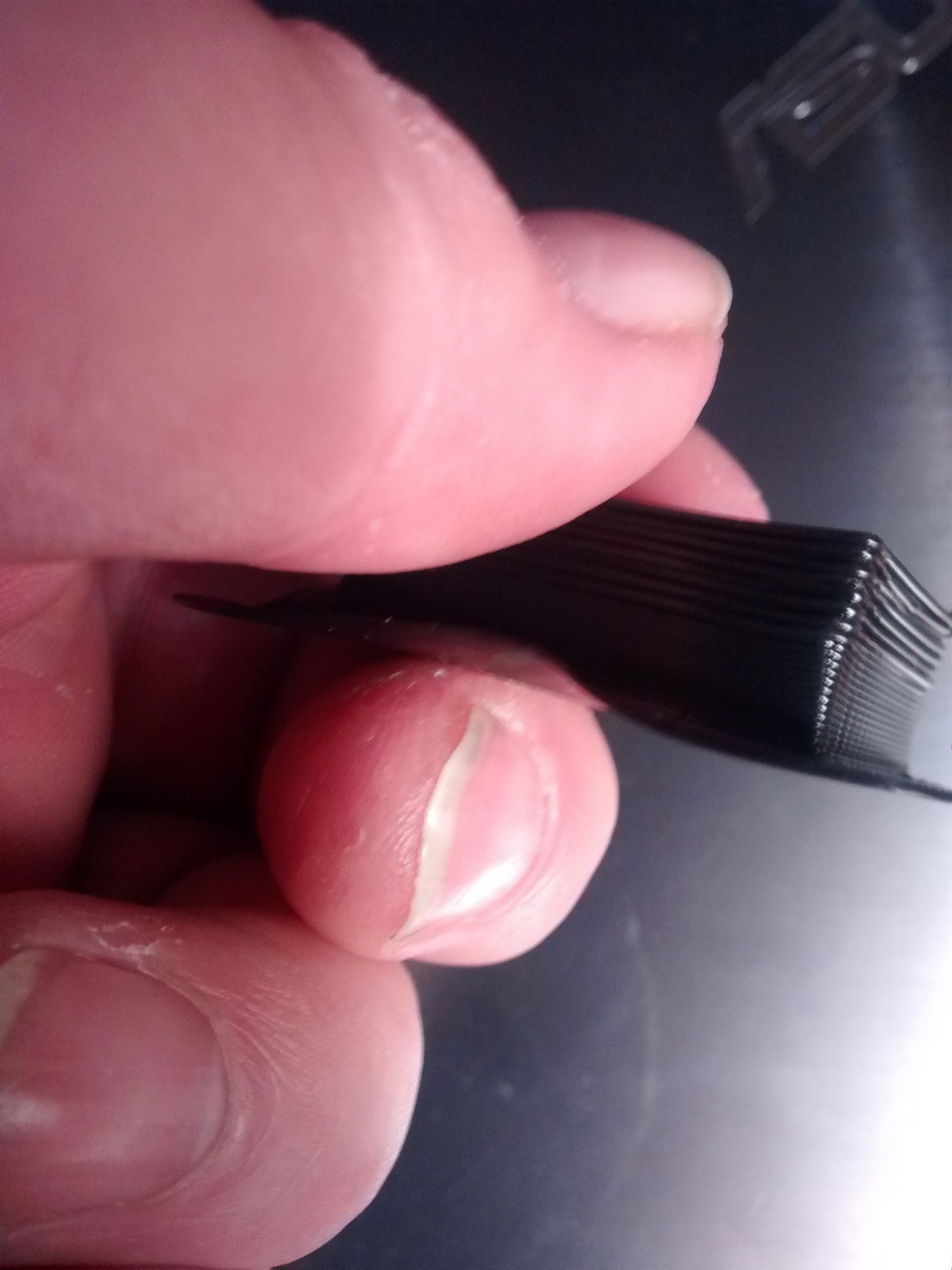Some infill not reaching walls ?
-
I think the linear/non linear extrusion correction will help, or at least enlighten. As the extrusion rate goes up the actual quantity of extruded material can drop.
You need to look at your slicer settings and convert then from speeds/layer thickness/track width to volumetric throughput, and finally to filament speed. My tests for the E3D v6 tend to too out around 5mm/sec filament speed, but you are likely to be higher. Pick 5 or six filament speeds covering from the lowest to slightly bove the highest as your test points.
My process is now starting with for example:
G1 E100 F120
...measuring the amount of filament taken in and then repeating the test with both the speed and filament distance increased by a suitable fraction to try and account for any short fall. Repeat this until I have it close to 100mm filament used and then go to the next test point. The final correction fraction used is the value you are interested in.This process does take some time.
After all this is done you should see than solid infill is fairly consistant for short or long infil lines. You may find you need to wind back the extrusion multiplier a bit to prevent over extrusion. 100% dense leaves no room for error!
-
Bowden tube has been replaced and excess couplers removed, better couplers have been installed, pa has been re-calibrated and retract has been reduced to compensate for a much higher pa value.
Speeds have been reduced to avoid the possibility of problems arising from exceeding volumetric capacity of the Volcano hot end.
While things are improving with every step, there is still a significant lag (but less than before) between wall and infill in some portions on the infill. At the same time, I can see extrusion start at the instance of head movement beginning on things like the outer walls so I know that the printer is capable to squirt out material the instant the nozzle moves.
Update:
Out of desperation I have gone to an overlap of 100% and added a 1 mm3 of extra prime amount after retraction. All but one wall to infill joint is complete but the one eludes me. You can see the extra prime amount at the beginning of the extrusion but it is a good mm away from the wall.
-
You can see that the other 'arm' next to the failed arm just barely reaches the wall despite the 100% overlap.
-
Here is the gcode for layer 4 and 5 as well as the .3mf filelayer4and5.gcode [0_1577049965879_CFFFP_duet roof molding sample.3mf](Uploading 100%) [0_1577049998995_CFFFP_duet roof molding sample.3mf](Uploading 100%) CFFFP_duet roof molding sample.txt
Note tha the .3mf file was renamed to .txt to allow upload
-
Let me approach this from a different angle:
The current print sequence is:
print inner wall
increase Z one layer
print first line of infill .... this is the line that has a delay in feeding filament
print rest of infill lines
print outer wall (I see a gap in starting with this on occasion)
print inner wall
repeat
The issue, a gap in extruded filament, presents itself primarily at the beginning of the first infill line on the new layer level but it can also show up at the very beginning of the wall (mostly outer).
Is there any setting that can delay printing or remove printing somehow ?
I notice there are some settings in the slicer to remove certain segments if they are too small or what-not. Is it possible that I have somehow screwed up one of those (one in several hundred) settings ?
Having said that, the infill line that is missing the beginning maybe 2 mm is maybe 20 mm long so not something that I would consider 'small' -
Unless somebody has a brilliant thought, I am giving up on this issue

I can mitigate things by choosing different infill patterns, modifying the patterns (doubling up lines) and more. The most promising modification is to randomize infill start which guarantees (more or less) that infill lines will connect to the wall at least 50% of the time.I looked at the specific g codes that are involved and I can't see anything wrong with the code. I suspect hardware but I think I have replaced everything that is involved so I am fresh out of ideas.
I have reduced my print speeds a bit as I think I hit volumetric limits with my high (0.8) pa settings. This small change will help me in the long run so my time digging for an answer wasn't for nothing.
Thanks for the help !
-
@jens55 said in Some infill not reaching walls ?:
increase Z one layer
print first line of infill .... this is the line that has a delay in feeding filament
print rest of infill lines
print outer wall (I see a gap in starting with this on occasion)
print inner wallThis seems like an odd print order to me. I prefer inner wall, outer wall, then infill.
I tried to open the .3mf file but I'm on Cura 4.4 and it crashes as soon as i try. Not sure if it's just because of the version mismatch or what.
Maybe upgrade cura?
Alternatively, try this custom branch of Cura that has a lot of fixes and features that never seem to make it into the main version. I prefer it.
https://www.dropbox.com/sh/s43vqzmi4d2bqe2/AAADdYdSu9iwcKa0Knqgurm4a?dl=0&lst=&preview=README.md
-
@Phaedrux, I changed the order to better watch what is happening on the infill lines.
I can't run 4.4 ... it worked only until the first time I tried to change printers (I have 2 configured printers) and now it crashes as soon as it starts up, possibly because it starts up on the second printer that I tried to switch to when the whole thing came crashing down.
I flip back and forth and it doesn't do me any good if one configuration crashes things so I decided to stick with 4.3 until 4.4.1 comes out and I can try again.
I will most certainly look at the branch that you linked ! Thanks !I didn't think there was anything worthwhile in 4.4 over 4.3 so it wasn't a priority for me.
-
In that case, definitely try that linked build. It installs separately to the main cura install with a fresh configuration.
Your crashing is quite likely a corrupted config file. It's happened to me a few times. I've had to torch my complete cura config and start fresh a few times.
-
Ok, for those of us that had too many of the gray cells in the brain die off from old age .... where in the link you posted can I get the Linux appimage they are talking about <feeling very stupid at this moment>
-
Duuuhhh, never mind .... found the teeny tiny back arrow <sigh>
-
Sorry I linked straight to the read me. Oddly though when I open it it goes to the main page with all the download links.
https://www.dropbox.com/sh/s43vqzmi4d2bqe2/AAADdYdSu9iwcKa0Knqgurm4a?dl=0
Try that maybe?
-
 Too many eggnogs?
Too many eggnogs? -
Must be
 ... Got it downloaded, installed and it started up ok. It even flipped to the second printer without crashing ... wooohoooo
... Got it downloaded, installed and it started up ok. It even flipped to the second printer without crashing ... wooohoooo
I will try running a print on it tomorrow.
Thanks! -
@jens55 said in Some infill not reaching walls ?:
Must be
 ... Got it downloaded, installed and it started up ok. It even flipped to the second printer without crashing ... wooohoooo
... Got it downloaded, installed and it started up ok. It even flipped to the second printer without crashing ... wooohoooo
I will try running a print on it tomorrow.
Thanks!Unfortunately, it does crash when I loaded your .3mf file that you provided on the Cura forum. I have a workaround for that crash so I can make a new build that will load that project OK. I will do that now and put it on Dropbox.
-
Have you done the checks for extrusion correction and single wall thickness?
Edit: A square single wall shape and measure the wall thickness and comparing it to the slicer targeted wall thickness will identify significant under extrusion. For this test I run the extrusion multiplier at 1, and adjust filament diameter to correct if needed.
-
Also check coasting, there is no need for that when using PA.
-
@DocTrucker said in Some infill not reaching walls ?:
Have you done the checks for extrusion correction and single wall thickness?
Something is amiss. On the previous test prints I had excellent surface finish. This time, doing a vase print, I ran into terrible surface finish.
As it happens, I installed a new version of Cura so at this point I am not sure if the issues are related or not. I will have to do some more tests but am unable to do it this morning.Quite honestly, I had not considered under-extrusion because the prints, other than the one or two joints between infill and wall, were very nice. I did recently go to a new filament and never bothered to measure the filament diameter. I now realize that size is a bit of a problem at 1.68 mm which could very well have caused some issues. Even then, it's difficult to see why under-extrusion would cause gaps on only one specific section of a print.
I did notice that on previous prints, the two outside walls were not joined well. That part could easily be explained by under-extrusion but not the gap between infill and wall.Stay tuned for more tests but not right away ....
Oh, coasting is off.
-
@burtoogle said in Some infill not reaching walls ?:
@jens55 said in Some infill not reaching walls ?:
Must be
 ... Got it downloaded, installed and it started up ok. It even flipped to the second printer without crashing ... wooohoooo
... Got it downloaded, installed and it started up ok. It even flipped to the second printer without crashing ... wooohoooo
I will try running a print on it tomorrow.
Thanks!Unfortunately, it does crash when I loaded your .3mf file that you provided on the Cura forum. I have a workaround for that crash so I can make a new build that will load that project OK. I will do that now and put it on Dropbox.
It worked. No more crash.
-
I backtracked to Cura 4.3 and backtracked some adjustments but no luck. The funny thing is that this issue only shows up on vase mode printing.

You can see proper wall building at the bottom and then it goes to excrement all of a sudden - very odd.
I also tried upping flow to 120% with no difference. I am currently out of ideas why this is happening because I printed in vase mode before with the 0.8 mm nozzle without any issues.Oh, I also reduced the trace width to 0.8 mm because I thought that maybe somehow that could have caused the odd vase print (I had only printed at 0.8 mm for vase mode before)
The sample you see was printed in vase mode, 0.8 mm width and 120% flow.